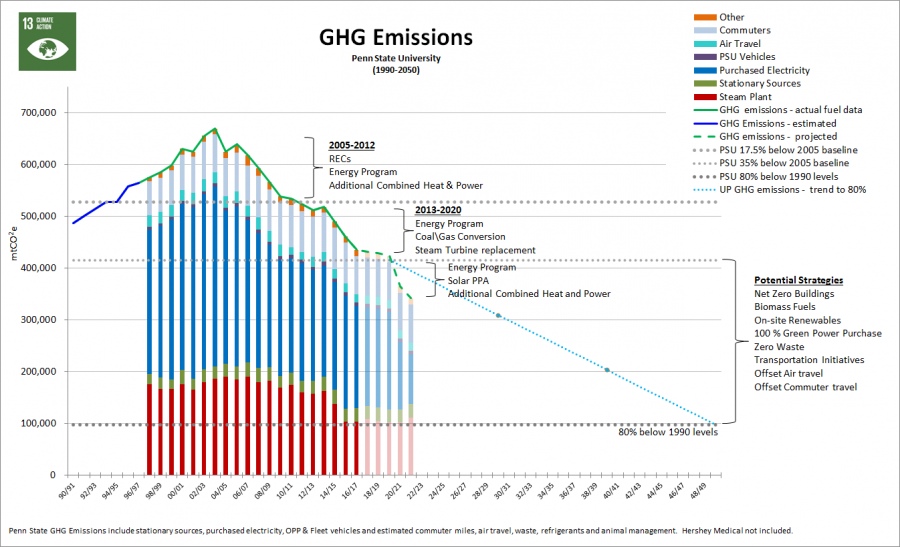We are! Reducing Emissions!
As we think about the unique opportunities that local scale climate action affords, it's worth exploring the unusual localities that are our university and college campuses. Well-delineated and largely autonomous, university campuses offer a different perspective on emissions accounting and reduction efforts. Beyond that, universities and colleges are home to the front lines of education and research related to climate change, and so it makes sense that their campuses could serve as living laboratories for addressing these important contemporary climate challenges.
Penn State has been tracking its greenhouse gas emissions annually since 2002. Fun fact: some of the initial work on this effort as well as their early mitigation planning was born out of the Department of Geography! As you can see in this graph below, not only is your university tracking its emissions, it has adopted relatively aggressive reduction targets and is working toward meeting them. It takes a lot of different efforts and initiatives, each working together, to pull that emissions trend downward. There is no magic carbon bullet here to save us - we must take aggressive incremental action to achieve our reduction goals. The recent Solar Power Purchase Agreement was the biggest piece of that puzzle in a while, and it will continue to pull that curve down by supplying 25% of the university's electricity needs, but even that is just a portion of the story.

You can learn more about the GHG Emissions Inventories (they track them for all 24 Commonwealth campuses, too!) and other sustainability-related initiatives here at Penn State by visiting Penn State Sustainability.
In April 2020, the University Faculty Senate* passed a climate action resolution calling for the administration to take the following actions:
- develop a university-wide climate action and adaptation plan
- reduce purchased electricity emissions by 100% by 2030
- reduce net GHG emissions by 100% by 2035
- increase investment in initiatives focused on climate science, solutions, and management
- engage peer institutions to raise awareness and reduce impacts of a changing climate
It's important to understand that Faculty Senate resolutions are non-binding. So even though this passed quite handily (the vote was 104-14), it didn't have any teeth in that it didn't then REQUIRE that the university do anything with it). It's more of a visible and tangible expression of the collective will of the faculty. And while they didn't have to do anything with it, I can tell you that (1) the administration knew it was coming and was supportive of it being taken up by the Senate and (2) have since started taking action! The administration has convened a carbon emissions reductions task force that is meeting regularly and working to develop an action plan. The prior instructor of this class, Brandi Robinson, was the author of this climate action resolution! While it was a collective effort with colleagues at the Sustainability Institute, she was able to bring it to her Senate colleagues for a vote!
One of the things about Penn State is that because it is so big, it can be very difficult to keep track of everything that's going on. The Sustainability Institute website has this nice summary of ongoing initiatives related to climate and sustainability, which may be of interest to you.
What about other colleges and universities?
Penn State is certainly not unique in its pursuit of ambitious environmental initiatives and greenhouse gas reduction efforts. However, Penn State was one of the early pioneers in this space. It's exciting to see the breadth and depth of work happening in this space now in a variety of formats:
- AASHE (Association for the Advancement of Sustainability in Higher Education)
- PERC (Pennsylvania Environmental Resource Consortium)
- Second Nature's University Climate Change Coalition
- Harvard - fossil fuel-free by 2050 and more recently the Harvard faculty votes to divest from fossil fuels
- Top Universities for Climate Action
- We Are Still In -University Climate Change Coalition
But, that's not to say we couldn't be doing more.
